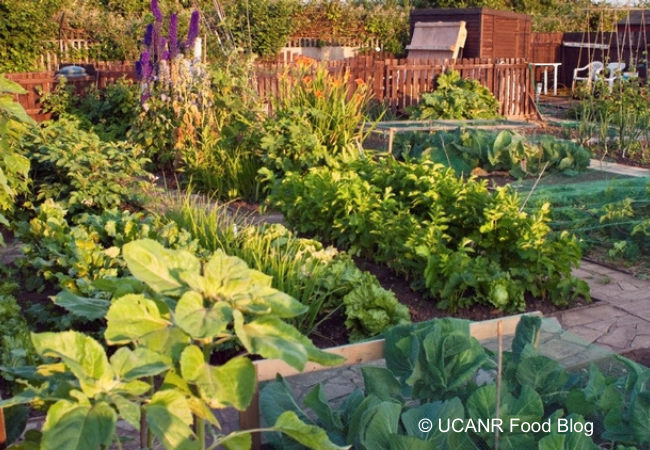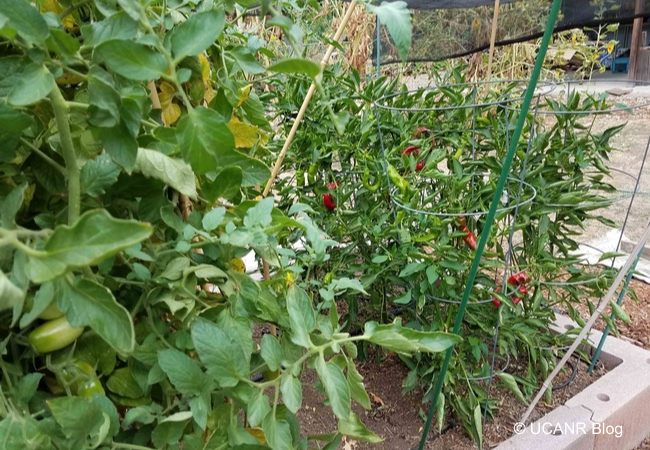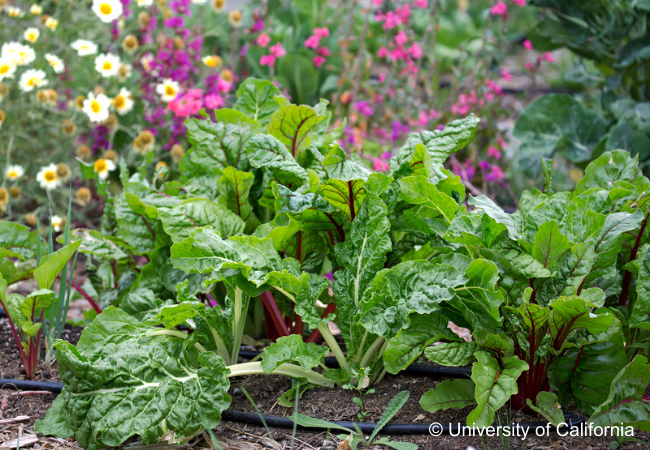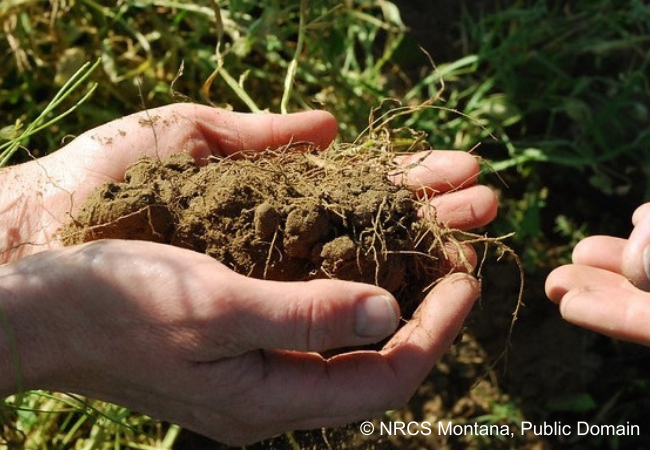- Author: James Farr
- Author: Linda Carloni
When the temperature starts to dip from the high 90s, and you are still picking ripe tomatoes and zucchini nearly every day, fall and winter gardens don't immediately come to mind. Although it may not feel like it, this is the time to be thinking ahead and planning for the next seasons.
We are wonderfully fortunate in the Bay Area that we live in a Mediterranean climate where we can grow vegetables all year round. Mediterranean climates make up only approximately three percent of the landmass on Earth, yet are among the best agricultural areas on Earth. The temperatures are warm in the inland areas but close enough to the ocean to cool down at night and also get an occasional fog. We are fortunate enough to be able to garden all year around and it is a shame not to take advantage of it and grow fresh vegetables in all four seasons.
Unless you have a greenhouse, you won't be growing tomatoes, zucchini, squash and the like in the winter, but many leafy greens (lettuces, kale, chard etc), root crops like garlic, beets, turnips, and rutabagas and cabbage and mustard family plants do very well in the winter with a little planning and care.
Planning the garden, where to plant?
When the garden is full of summer vegetables, it may be hard to think about where to plant fall/ winter vegetables. Do you need to start ripping out some of your summer vegetable plants early? Sometimes, but not always. A little planning will help. Some vegetables, like tomatoes and zucchini, will naturally slow in their production and will die completely at the first frost.
For plants in the nightshade family (like tomatoes, eggplants, peppers and potatoes, you will want to dig these up completely from your garden. Plowing them under can cause disease issues because they are highly susceptible to soil-borne fungal diseases, which would be promoted if the plants are plowed under. Note: in coastal areas of Alameda County without frost, tomato plants can sometimes be grown all year around.
But if you don't need to fully dig up a summer plant and its roots, it is ok to plant some of the fall/winter vegetables between the summer vegetables. Just be careful not to plant them where they might be accidentally pulled up when you do cut off or remove the summer plants. Previously it was believed that the planting bed had to be denuded of the earlier crop and maybe even left fallow for a time before replanting in that space. Newer research shows that plants grow better when a variety of other plants grow nearby. For example, planting the new winter seedlings among the larger summer-bearing plants allows the foliage from the older plants to offer sun protection to tender seedlings.
When planting in between existing plants, add some compost or fertilizer as suitable for the new plant. You may also need to increase the watering frequency if/when the temps remain hot. Once the summer plant is no longer productive (unless it needs to be completely removed because of disease concerns) you can just cut the top of the plant off at ground level, leaving the root system in the soil to decay and avoiding disturbance to the soil ecosystem.
The Master Gardeners of Butte County have written an excellent article on using “no-till” gardening and succession planting methods that build up the health of the soil.
What Are Cool Season Vegetables?
Cool-season crops are those that grow best and produce the best quality when the average temperatures are 55 degrees F to 75 F and are usually tolerant of slight frosts. There is a large variety of these vegetables to choose from.
Brassica, plants in the cabbage and mustard family
Vegetables that do well in our cool months include members of the Brassica genus (cauliflower, broccoli, brussels sprouts, cabbage, collard greens, turnips, bok choy, and kale). In addition to growing well in cooler weather, brassicas are less susceptible to cabbage moths when the weather is cooler.
Leafy greens and herbs
Leafy greens such as spinach, lettuce, arugula, and Swiss chard also grow very well in cooler months, as do leafy herbs such as parsley and cilantro. In fact, many of these vegetables grow more abundantly in cooler weather and do not bolt and go to seed as easily as they do during hot summer days.
Onions and Garlic
Both bulb and green onions can be planted in the fall for a late spring or early summer harvest, or in the winter for a late summer or fall harvest next year. Garlic is generally best planted in the fall for the largest size bulbs at harvest. While garlic is fairly easy to grow, see below for practical tips for onion gardening success - they are more complicated than it seems.
Carrots, Beets, Swiss Chard and Peas
And don't forget that some favorite vegetables can be grown all year round in the Bay Area. These include carrots, beets, peas and swiss chard. These favorites can be planted in early Spring for an early Summer harvest and planted again in late Summer to enjoy a year-round bounty.
When to Plant?
As always, the microclimates of our Bay Area, and even within your yard, will affect the location and timing of your planting. On the east side of the East Bay hills (e.g., Livermore, Pleasanton, and Dublin) late summer and early fall temperatures typically are higher than west of the hills (e.g., Albany, Berkeley, Oakland and Alameda). Higher temperatures are also found in the sunny side of your garden that has a lot of southern exposure. Watch your local weather forecasts for high temperatures before you plant. Seeds of course can be started indoors regardless of the outdoor weather. But avoid outdoor seed sowing and transplanting seedlings during a heatwave, or the hottest part of the day even on average temperature days.
Seeds v. Seedlings - Pros and Cons
Some types of plants do better when planted by seed directly into the garden - for example, most root crops. This is noted in the Tips table below. But others can be planted either from seedlings (purchased or self-grown) or seeds.
Here are the pros and cons to keep in mind when choosing the method of planting:
|
Pros |
Cons |
|
Seeds |
|
|
|
|
Seedlings |
|
|
|
Tips for Fall/Winter Vegetables |
||
|
Vegetables |
Fall Planting Method and Timing |
Notes |
|
Cole crops (brassicas) |
Protect seedlings/seeds against cabbage moth larvae with lightweight floating row cover until temps drop. |
|
|
Broccoli, Cauliflower, Cabbage |
Seedlings; July to Sept |
Broccoli: Inland, a cold snap with near-freezing temps may stunt young seedlings if planted late. Periodically fertilize lightly with nitrogen source 2 -3 weeks after planting. |
|
Asian Greens - Bok choy, tatsoi, Napa cabbage |
Either; Aug to Oct |
Bok choy may bolt if planted when temps are too warm. |
|
Leafy greens |
Lettuce and arugula are particularly suited to containers, even ones only 6 to 9 inches deep. Chard and kale need containers 12 to 18 inches deep. Lettuce and arugula are particularly suited to containers, even ones only 6 to 9 inches deep. Chard and kale will do better in containers that are 12 to 18 inches deep. |
|
|
Lettuce |
Time planting so plants mature in cool weather. Time to maturity varies by variety. |
Prefers fine soil. Amend before planting with fine compost or planting mix. Harvest first by thinning. As plants grow, harvest two to three leaves per plant so the rest can keep growing. Harvest the whole by pulling or cutting anytime. Protect from excessive heat and insects. Need frequent light watering. |
|
Arugula |
Aug (seeds) or Sept (either) to Oct |
Younger leaves are milder; plants prefer cool temperatures. Shallow-rooted, likes frequent water. Will regrow if a few are left to re-seed. |
|
Swiss chard |
Either. Aug - Oct |
Requires well-amended soil, fertilizer at planting and plenty of water. Harvest outer leaves continuously once fully expanded. |
|
Collards* |
Either. Aug (cooler regions) or Sept, through Oct |
Requires well-amended soil, fertilizer at planting and plenty of water. Start harvest with a few outer leaves when there are about 10 leaves. For larger plants you can harvest up to 50% of leaves at a time. |
|
Kale* |
Select early maturing varieties. Needs a lot of nitrogen. Use row covers to protect from frosts and pests. Deep and infrequent watering, even moisture. As plant grows, harvest lower leaves at 5 to 8 inches long. |
|
|
Mustards* |
Use row covers. |
|
|
Spinach |
Either. August and September |
Fast-growing and nutritious. Amend the bed, sprinkle seed about half an inch deep, cover lightly with soil. Thin with tiny scissors at the soil line when crowded. Likes full sunlight, but in hot early fall, may need light afternoon shade. Frequent irrigation. Keep watch for snails and slugs. |
|
Onions and Garlic |
||
|
Onions (bulbing) |
Seeds, Sept to mid-Oct |
Plant intermediate day seeds indoors in starter mix and set out under lights. Keep moist. After seedlings emerge, use dilute fertilizer every 2 - 3 weeks. In Dec or Jan when the greens are still smaller in diameter than a pencil, transplant to final outdoor bed, adding compost and fertilizer. Transplanting when the greens are bigger causes bolting. Harvest only after the stalks have fallen over. For more details on the differences among onion variety “day lengths”: https://mgsantaclara.ucanr.edu/garden-help/vegetables/onions/ |
|
Onions (green or bunching) |
Seeds or seedlings: Aug to March. |
Needs well-amended soil, frequent watering. Harvest when ¼ to ½ inch in diameter. |
|
Garlic (bulbs) |
Bulbs, Oct - Feb |
Use certified garlic bulbs to avoid disease. Plant pointy-end-up, one inch down and four inches apart. Amend the soil well before planting; add fertilizer at planting and once in the spring. Keep soil moist but not wet; depending on rains, you may not need to water at all. Cut watering at least 50% in May when the leaves start yellowing. When the leaves turn brown, stop all watering, and harvest carefully in a few weeks. |
|
Root vegetables |
||
|
Carrots |
Seeds, August |
Plant in finely textured well-irrigated soil. Carrots can be a bit tricky in a warm fall because the seeds take a long time to germinate and must be kept moist. Plant seeds 1/4 inch deep. Covering the seed bed with moist newspaper or burlap can keep moisture in but check frequently under the cover to make sure you aren't squashing the seedlings. Take off the cover as soon as seedlings emerge. Thin when sprouts are about 2 inches high. As the seedlings grow, water less often, more deeply and with less total water. |
|
Beets |
Seeds preferred if growing for bulbs. Aug - Oct |
Amend soil and add a fertilizer low in nitrogen and high in phosphorus and potassium. Keep the plants moist and mulch to keep roots cool if the weather is warm. Plant seed 1/2 inch deep and one to two inches apart; thin to four inches apart when seedlings have 2 true leaves. |
|
Rutabagas* & Turnips* |
Seed in Aug-Sept, transplant in Sept - Oct |
Plant seeds in full sun in amended loose soil. Use row cover to protect from caterpillars. Plant rutabagas ¼ in deep, turnips ¼ to ½ in. Avoid excess nitrogen, which may cause misshapen roots. Harvest rutabagas when roots reach 3 - 5 inches; turnips when at 2 - 3 inches. Cold and frost (not freezes!) make bulbs sweeter. |
|
Peas |
Prone to powdery mildew; some varieties are resistant. |
|
|
Sugar, snap, English |
Seeds or seedlings. Sept - Nov |
Need fertile, well-drained soil. Light, frequent irrigation. All need support - a trellis of 3 to 4 feet for bush peas and 6 to 8 feet for pole peas. Harvest with pruners, starting from the bottom. |
|
Veggies with * are also brassicas but are grouped with non-brassica plants with similar characteristics |
||
For more information on planting times, these other planting charts for the Bay Area can be helpful:
When is the right time to remove summer vegetable plants?
In general, many summer vegetable plants will die at the first winter frost. Winter vegetables will often be planted before that happens. It is ok to plant winter vegetables between summer vegetable plants which can offer some protection for the new winter plants. However, well before the first frost, summer vegetables will slow in their production and also will start showing signs of aging such as slower growth, browning of leaves, mildew on leaves and lower sugar content in vegetables such as tomatoes. These are all signs that these vegetables could be removed to make room for winter vegetables.
Everything starts with the soil: Give your soil some tender loving care
One of the first things to think about once you have chosen what you want to grow and where to grow it, you will need to think about giving your soil some TLC: tender loving care. Everything starts from the soil, healthy soil will give the best chance for your plants to be strong and healthy. Poor soil will make it more difficult to get a satisfactory crop of vegetables. Growing vegetables year-round in the same space will generally require additional soil amendment or fertilizing between crops. For more information about soil amendments see: https://ucanr.edu/sites/mgslo/files/313434.pdf
How do I know if my soil is “good” or “poor”? There are some very simple visual tests. If you dig into the soil and see plenty of worms, your soil is healthy and may require only more nutrients to give your plants a good start. Worms are like the canary in the mine: when they are present and alive, it is a green light to plant in the soil. If there are no worms, then chances are your soil probably lacks some critical component, most notably organic matter such as decaying leaves or plant matter that is broken down or “composted”. Adding compost will "feed" the soil, worms and your plants.
Secondly, good soil often can be worked with the minimum use of tools. For example, if your soil has a good proportion of clay, silt and sand then when slightly moist, the soil should be able to be dug with your bare hands. Soil with a high proportion of clay often is hard to work. Soil that does not retain water (dries out very fast) likely has too high of a proportion of sand. You may read more about soil and soil chemistry from our sister program in Placer County.
Some other tips for planting your winter garden include:
-
Work compost into the top few inches of soil before planting or place it around existing plants. For more information on compost see: Improve Your Soil With Compost - UC Master Gardener Program of Alameda County
-
Add small amounts of fertilizer such as fish emulsion to young plants. Be careful to follow the instructions carefully on the bottle. For more information on fertilizer see the articles:
Home Gardening Fertilizing Part 1: Fertilizers 101 - UC Master Gardener Program of Alameda County
Home Gardening Fertilizing Part 2: Spring Is Here. Is It Time to Fertilize?
-
Monitor soil moisture around seedlings and transplants during the drier months of September and sometimes October. In some years fall in the Bay Area may not see rain until mid to late October. So water your garden during these periods until the rains arrive.
Protecting your Winter Vegetables from Critters
One of the most frustrating aspects that gardeners face in winter gardens is how to deal with all the critters who want to eat your vegetables. You have to remember that insects and larger animals all have a need for food. When the supply of food around them is less abundant than it was during the summer, your vegetable garden looks like an oasis of food waiting to be eaten. While insect populations are generally less in the winter, there is still a need for a variety of strategies that can protect your vegetables without having to resort to chemical sprays. If the infestations are not heavy, simply removing the insects by hand can be effective. Netting plants or using various kinds of traps with attractants can also be used where heavier infestations are likely. When sprays are needed for heavy infestations there are a variety of safe, low-toxicity alternatives.
Success! The Fruits (Vegetables?) of Your Labor
There is nothing like picking fresh greens, carrots, potatoes, etc. from your winter garden. When the weather is cold and rainy, a good hot soup or stew made from fresh vegetables from your garden is the best way to warm up your house and satisfy your appetite.
References:
For further information about growing specific vegetables, see
For further suggestions on garden tasks month by month, see:
For further general information on vegetable gardening, see:
Planting Vegetables from Transplants:
Planting Vegetables from Seeds:
This blog post is brought to you by the Help Desk of the Master Gardeners of Alameda County. Subscribe to our blog!
Have a gardening question? We'll help. You can reach us by:
-
Emailing acmg@ucanr.edu. Please include a photo of the problem, if you can, plus your name, phone number, city and a description of the problem.
-
Using our online form.
-
By phone, during our office hours, 10 am to noon Wednesday and 11 am to 1 pm Thursday: 510-670-5645. At other times, please leave a message and we'll return your call during our office hours.
-
In person at our Hayward office, during our office hours, only by appointment.






